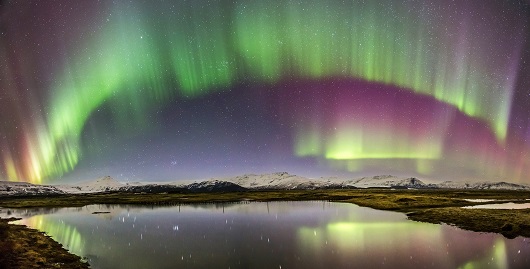Casting light on black auroras

Satellite data reveals of the secrets of how the dark cavities in the Northern Lights are created
Satellite data collated over almost 15 years has allowed an international research team, including Andrew Wright of the University of St Andrews’ School of Mathematics and Statistics, to develop the first accurate model of the electric fields and currents at the heart of black auroras.
The research, published today, not only sheds light on the black phenomena which subdivide the glowing curtains of red and green light visible within the Northern Lights; but will also allow the aviation industry to better understand the ionosphere and the ways it might affect radar and radio signals.
The scientific collaboration came about as a result of a series of workshops led by Andrew Wright at the International Space Institute in Switzerland.
Four Cluster spacecraft operated by the European Space Agency have been orbiting earth, reporting back data since 2001; including details of electrical fields, magnetic fields and particle populations. By flying in close formation through the Earth’s magnetosphere – the spacecraft have gathered a treasure-trove of multi-point observations which help to explain the physical processes that create the dark cavities that can be observed within the shimmering auroras of the Northern and Southern lights.
Wright and the team have used this data to generate a computer model that explained the dynamic behaviour of black auroras.
Wright explained:
“For the first time we are able to reproduce the phenomenon of the black aurora and in particular what happens in its heart, where strong electric fields are present. We hope that this will lead to a better understanding of the interaction between the upper atmosphere and the space environment.”
Black aurora take various forms – dark rings, curls or black blobs in a sea of faint, glowing aurora. The patches of black aurora are caused by a kind of ‘anti-aurora’, where conditions are the exact opposite of those in the normal aurora. The black aurora occurs where there are holes in the ionosphere, the part of the upper atmosphere where aurorae are created. Here, the particles that make up the ionosphere are shooting upwards into space inside regions known as positively charged electric potential structures. This is the opposite process to that which creates visible aurorae, where electrons spiral down from space into the atmosphere within similar, but negatively charged, structures.
The research published today in the Journal of Geophysical Research demonstrates the physical relationship between these two currents. Lead author of the research paper Alexander Russell, a post-doctoral research fellow at the University of Dundee, said:
“Our model demonstrates how the two-way electrodynamic coupling between the magnetosphere and ionosphere works. This is made possible by a horizontal drift of ions in the ionosphere, known as the Pedersen current, which closes the current system.”
Philippe Escoubet, ESA’s Cluster project scientist, commented:
“The modelling of the ionosphere’s physical state is of prime importance in our modern technological society. For example, GPS signals can be modified by changes in electron content in the ionosphere so that their navigational and timing accuracy are significantly reduced. Improved modelling of the ionosphere is necessary to make the necessary corrections.”
ENDS
NOTES TO NEWS EDITORS
“Magnetospheric signatures of ionospheric density cavities observed by Cluster” by A. J.B. Russell, T. Karlsson and A.N. Wright is published in Journal of Geophysical Research – Space Physics, issue 120, April 2015.
This research developed out of a series of workshops hosted by the International Space Science Institute: http://www.issibern.ch/
Cluster is a constellation of four spacecraft flying in formation around Earth. It is the first space mission able to study, in three dimensions, the natural physical processes occurring within and in the near vicinity of the Earth’s magnetosphere. Launched in 2000, it is composed of four identical spacecraft orbiting the Earth in a pyramidal configuration, along a nominal polar orbit of 4 × 19.6 Earth radii (1 Earth radius = 6380 km).
Cluster’s payload consists of state-of-the-art plasma instrumentation to measure electric and magnetic fields over wide frequency ranges, and key physical parameters characterising electrons and ions from energies of near 0 eV to a few MeV. The science operations are coordinated by the Joint Science Operations Centre (JSOC) at the Rutherford Appleton Laboratory, United Kingdom, and implemented by ESA’s European Space Operations Centre (ESOC), in Darmstadt, Germany.
For details of the Cluster visit: http://sci.esa.int/cluster
Photo credit: Carlos Gauna
Category Research